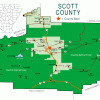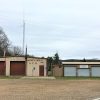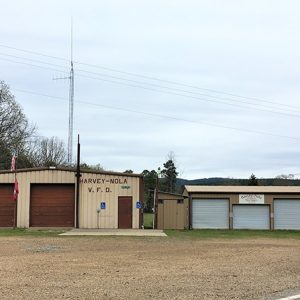calsfoundation@cals.org
Harvey (Scott County)
Harvey is an unincorporated community in eastern Scott County, near the border of Yell County. Harvey is within close proximity to the community of Nola (Scott County), just two miles east along Highway 28. The area where Harvey and Nola are located was once known as Nebraska (Scott County).
The area along the Fourche La Fave River valley was once a wilderness thick with timber and wildlife. Archaeological evidence shows Archaic, Woodland, and Mississippian peoples living in the area. Prior to European exploration of Arkansas, the Caddo tribe lived along the Fourche La Fave River valley, and burial mounds and other archaeological sites can be found along the river.
In the late seventeenth and early eighteenth centuries, French hunters and tradesmen traversed the Arkansas River and its tributaries in exploration westward from the Arkansas Post, possibly leading them down the Fourche La Fave River.
Prior to the Civil War, there were few families living in the area. The Kelley family was one of the first to settle in what became Harvey. Jerry Kelley built and operated an ox-powered cotton gin that was located on Kelley Creek, named after the Kelley family. After the war, Jerry Kelley’s former slaves accompanied his family to Scott County. The Kelleys were well-respected farmers in the area, known for having some of the finest horses in the state. Jerry and his sons ran a local store between Harvey and Nola and issued their own scrip for money. Monroe Cemetery was established just east of Harvey around 1873.
Harvey grew as an agricultural community after Reconstruction. One of the first churches located in Harvey was near Sulphur Creek, a tributary of the Fourche La Fave River. The church was organized by a Baptist congregation; however, it was given to a Methodist congregation after it agreed to finish constructing the roof and ceiling of the church. After the church was finished, both congregations held revivals there. A lodge hall was located near the church, and the Woodsmen of the World fraternal organization met there. A grist mill and sawmill were located on Sulphur Creek in the late nineteenth century. There were two stores located in Harvey in the 1890s. One store was owned by Amzi Watkins, while the other was owned by Doc Monroe. Harvey’s first post office opened in 1893 and was located in Doc Monroe’s store. The first postmaster was Samuel J. Cockreham. Monroe also owned a grist mill and blacksmith shop located near the store.
In May 1882, the Scott County Courthouse burned, destroying all records that defined the boundaries of the various school districts that had been established throughout the county. Several months later, in August, the county court re-established the boundaries of the fifty-six school districts active in the county, including Harvey School District (Number 1). The Harvey school wasfirst named La Fave School District after being re-established. The school name was later changed to Oakridge around 1900. It was not until 1909 that the name Harvey was applied to the school. This school house was located near where Highway 28 crosses Sulphur Creek. The school was later moved in 1918 near the community post office and stores. One of the first teachers in the school was Betty McQuery, who reportedly rode her horse from Waldron (Scott County) to Harvey every week in order to teach.
During World War II, several members of the Harvey community served in the military. After World War II, Harvey’s population began to decline. In 1950, the Harvey school was consolidated with the Waldron School District. The loss of citizens and industry around Harvey led to the closure of businesses, institutions, and organizations.
The landscape surrounding Harvey consists of the vast Ouachita National Forest and some agricultural land. Hunting within the Ouachita National Forest and fishing along the Fourche La Fave River are popular recreational activities. The Harvey Post Office is still in operation as of 2018, making it one of only a few rural post offices left in the county, while the Harvey-Nola Rural Fire Department provides fire protection and serves as a center of social activity. The Assembly of God church remains active in the community.
For additional information:
Cate, Michael. History of Scott County, Arkansas. Dallas, TX: Curtis Media Corporation, 1991.
Echoes: The Scott County Historical and Genealogical Society Quarterly. Waldron, AR: Scott County Historical and Genealogical Society (1986–).
Goodner, Charles. Scott County in Retrospect. Mansfield, AR: Frank Boyd, 1976.
Goodner, Norman. A History of Scott County, Arkansas. Siloam Springs, AR: Bar D Press, 1941.
McCutcheon, Henry Grady. History of Scott County, Arkansas. Little Rock: H. G. Pugh and Company, 1922.
Ty Richardson
Richardson Preservation Consulting
 Nebraska (Scott County)
Nebraska (Scott County) Nola (Scott County)
Nola (Scott County) Harvey-Nola Fire Department
Harvey-Nola Fire Department  Scott County Map
Scott County Map 




Comments
No comments on this entry yet.